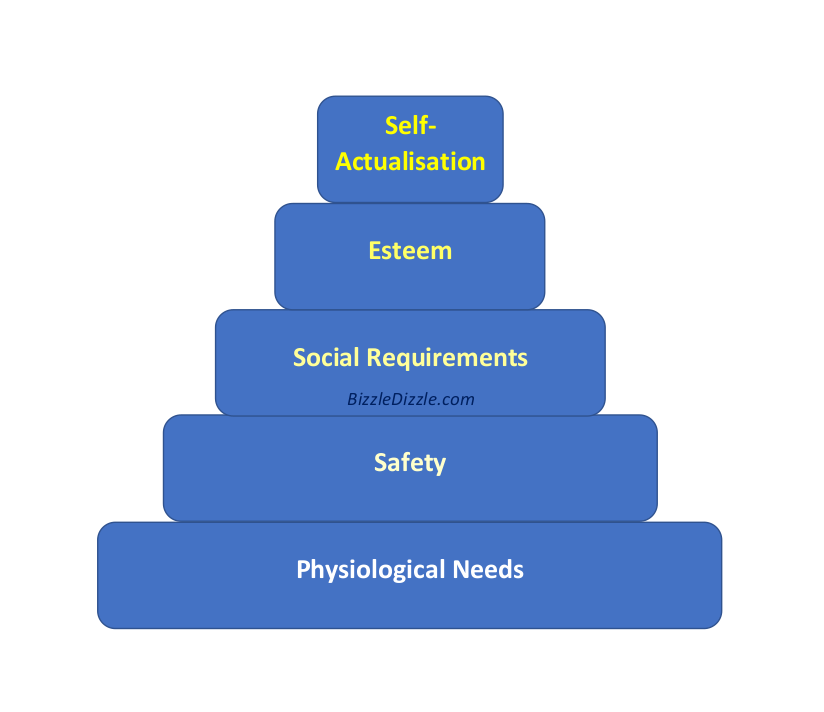The term motivation is used a lot in business. Motivation affects staff and customers. The appreciation of a need that has not been fulfilled often drives people to fulfil that need. Maslow’s Hierarchy of Needs is the pyramid that defines different aspects of an individual’s needs in terms of the most fundamental elements at the bottom of the pyramid of needs, through to more complex needs at the top. Maslow’s model focuses on the lower parts of the pyramid needing to be fulfilled before higher levels of the pyramid can be attempted. No matter where in the pyramid, each need requires recognition by the individual to become their need. It is the responsibility of a manager or sales person to create a solution for an unmet need once customer on member of staff has realised that their needs not met. In business, higher levels of the pyramid are the main focus, because lower fundamental levels are often realised before a person has the opportunity to work in a customer focussed environment. This is assuming that that term safety relates to fundamental elements of an individual’s life e.g. having somewhere to live, not feeling threatened in their home environment and having basic protection offered by law and policing of laws.
The Levels of Hierarchy
Once the needs at the bottom of the Maslow’s Hierarchy of Needs pyramid are met, the model suggests that they are no longer needs. This means that the needs higher up pyramid become the only (and most important) needs of the individual. The manager must realise which needs are required by the members of staff. Sales teams and people in marketing need to understand the needs of the customer and how they fit into the model. Since Maslow’s Hierarchy of Needs was introduced, other academics studying business have suggested that needs can be met simultaneously or that needs within the hierarchy pyramid require meeting in a different order depending on the circumstances faced. Models suggest that needs can be different at different times depending on the situation that the individual finds themselves in and the objectives at that moment in time. However virtually all academics understand that people’s needs to be addressed in order for a company to be as successful as it can be.

At the bottom of Maslow’s Hierarchy of Needs pyramid are the physiological needs. This focusses on the basic needs to sustain life. These include sleep, keeping hydrated and having enough oxygen to breathe. Without these necessities, it would be impossible for a person to function (or exist). Therefore, these are the essential needs and not many academics will argue with people about the necessity for these needs to be met before the next stages of realising, evaluating and addressing a person’s needs can be done.
The next step of the pyramid is safety. Safety is considered the second most essential need. If a person feels that they are going to be harmed or that there is a threat of attack, they will not be focused on their ultimate goals and ambitions. Therefore, safety is paramount before higher levels of need can be evaluated.
The third step of the pyramid addresses social requirements. Individuals often feel that they need to belong (we could add a whole phycology article here!). This is belonging to groups or associations, or simply having a circle of friends that the individual meets with on a regular basis. Most academics agree that this need can only be met once a person has the essential needs, or physiological needs, before they can address higher needs. This is where it may be argued that the next levels may happen simultaneously on not necessarily in the order that they appear in the Maslow’s Hierarchy of Needs pyramid. An individual may need to feel that they belong in order to feel safe. This may be by keeping friends close by, being involved with an association (e.g. a neighbourhood watch scheme) and in some extremes belonging to a gang. This belonging can actually create the feeling of safety for some individuals. Therefore, the safety need may be met as a result of achieving an individual’s needs in terms of their social environment. Whatever the readers own thoughts are, most people will agree that both social and safety needs are some of the most fundamental in order for more complex needs such as esteem to be addressed.
The third step of the pyramid is esteem. Esteem is how people think about themselves and the way in which they believe others view them. Esteem is concerned with achievements, recognition, reputation, career advancement and respect. With regard to business, in branding there are often to elements to consider. These are esteemed value and use (or functionality) value. For example, products that require association with a high level of functionality and dependability in order to be purchased, such as a petrol lawn mower, may require branding that delivers association with strong, useful product. On the other hand, a company that manufacturers designer handbags may require more of an esteemed value with their branding so that people actually attribute a higher value or cost to the product without it offering anymore function that alternatives made by other manufacturers.
Top of the Maslow’s Hierarchy of Needs Pyramid
At the top of Maslow’s pyramid is self-actualisation. Self-actualisation needs are met when an individual realises that they have unique skills, qualifications and experience which allow them to function or do a task that most other people are unable to do with the same efficiency, grace or quality.